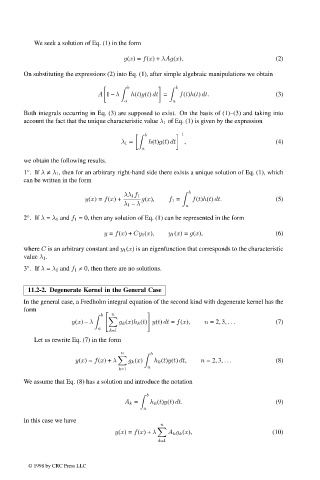Page 547 - Handbook Of Integral Equations
P. 547
We seek a solution of Eq. (1) in the form
y(x)= f(x)+ λAg(x). (2)
On substituting the expressions (2) into Eq. (1), after simple algebraic manipulations we obtain
b b
A 1 – λ h(t)g(t) dt = f(t)h(t) dt. (3)
a a
Both integrals occurring in Eq. (3) are supposed to exist. On the basis of (1)–(3) and taking into
account the fact that the unique characteristic value λ 1 of Eq. (1) is given by the expression
b
–1
λ 1 = h(t)g(t) dt , (4)
a
we obtain the following results.
1 .If λ ≠ λ 1 , then for an arbitrary right-hand side there exists a unique solution of Eq. (1), which
◦
can be written in the form
b
λλ 1 f 1
y(x)= f(x)+ g(x), f 1 = f(t)h(t) dt. (5)
λ 1 – λ a
2 .If λ = λ 1 and f 1 = 0, then any solution of Eq. (1) can be represented in the form
◦
y = f(x)+ Cy 1 (x), y 1 (x)= g(x), (6)
where C is an arbitrary constant and y 1 (x) is an eigenfunction that corresponds to the characteristic
value λ 1 .
◦
3 .If λ = λ 1 and f 1 ≠ 0, then there are no solutions.
11.2-2. Degenerate Kernel in the General Case
In the general case, a Fredholm integral equation of the second kind with degenerate kernel has the
form
n
b
y(x) – λ g k (x)h k (t) y(t) dt = f(x), n =2, 3, ... (7)
a
k=1
Let us rewrite Eq. (7) in the form
n b
y(x)= f(x)+ λ g k (x) h k (t)y(t) dt, n =2, 3, ... (8)
a
k=1
We assume that Eq. (8) has a solution and introduce the notation
b
A k = h k (t)y(t) dt. (9)
a
In this case we have
n
y(x)= f(x)+ λ A k g k (x), (10)
k=1
© 1998 by CRC Press LLC
© 1998 by CRC Press LLC
Page 530

